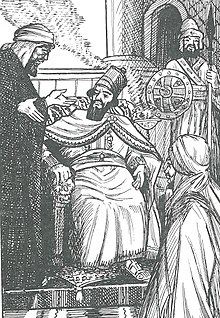Sayf ibn Dhi-Yazan

1935 illustration of Sayf asking for military assistance from the Sasanian king Khosrow I.
Abū Murra Sayf bin Dhī-Yazan (Arabic: سيف بن ذي يزن) was a Himyarite king of Yemen who lived between 516 and 578 CE, known for ending Aksumite rule over Southern Arabia with the help of the Sassanid Empire.[1] .[2]
To reconquer Yemen, Sayf asked Khosrau I king of the Sasanian Empire to help him fight the Askem. Khosrau agreed and sent 800 men with Wahriz as their leader. Masruq ibn Abraha, king of Yemen, confronted the army but lost in the battle. The Sasanians advanced to conquer San'a, however, Sayf was instated as King on the understanding that he would send taxes to Khosrau. He was later stabbed by Ethiopian servants, and the Sassanians reconquered Yemen and Vahriz was instated as Governor of Yemen, alongside Sayf's son.[1][3]
Popular culture
Sayf entered Arab folklore by means of his widely known "biography" Sīrat Sayf ibn Dhī-Yazan that accounts his conquests of the human and mythical jinn realm, blending historical facts with arab folklore and mythology.[4][5] Yazan has become a popular boy name in contemporary Arab culture.[6]
References
^ ab Hoyland, Robert (2002). Arabia and the Arabs: From the Bronze Age to the Coming of Islam. Routledge. pp. 56–57. ISBN 9781134646340..mw-parser-output cite.citation{font-style:inherit}.mw-parser-output .citation q{quotes:"""""""'""'"}.mw-parser-output .citation .cs1-lock-free a{background:url("//upload.wikimedia.org/wikipedia/commons/thumb/6/65/Lock-green.svg/9px-Lock-green.svg.png")no-repeat;background-position:right .1em center}.mw-parser-output .citation .cs1-lock-limited a,.mw-parser-output .citation .cs1-lock-registration a{background:url("//upload.wikimedia.org/wikipedia/commons/thumb/d/d6/Lock-gray-alt-2.svg/9px-Lock-gray-alt-2.svg.png")no-repeat;background-position:right .1em center}.mw-parser-output .citation .cs1-lock-subscription a{background:url("//upload.wikimedia.org/wikipedia/commons/thumb/a/aa/Lock-red-alt-2.svg/9px-Lock-red-alt-2.svg.png")no-repeat;background-position:right .1em center}.mw-parser-output .cs1-subscription,.mw-parser-output .cs1-registration{color:#555}.mw-parser-output .cs1-subscription span,.mw-parser-output .cs1-registration span{border-bottom:1px dotted;cursor:help}.mw-parser-output .cs1-ws-icon a{background:url("//upload.wikimedia.org/wikipedia/commons/thumb/4/4c/Wikisource-logo.svg/12px-Wikisource-logo.svg.png")no-repeat;background-position:right .1em center}.mw-parser-output code.cs1-code{color:inherit;background:inherit;border:inherit;padding:inherit}.mw-parser-output .cs1-hidden-error{display:none;font-size:100%}.mw-parser-output .cs1-visible-error{font-size:100%}.mw-parser-output .cs1-maint{display:none;color:#33aa33;margin-left:0.3em}.mw-parser-output .cs1-subscription,.mw-parser-output .cs1-registration,.mw-parser-output .cs1-format{font-size:95%}.mw-parser-output .cs1-kern-left,.mw-parser-output .cs1-kern-wl-left{padding-left:0.2em}.mw-parser-output .cs1-kern-right,.mw-parser-output .cs1-kern-wl-right{padding-right:0.2em}
^ Power, Timothy (2012). The Red Sea from Byzantium to the Caliphate: AD 500-1000. Oxford University Press. pp. 76–77. ISBN 9789774165443.
^ Azmayesh, Dr Seyed Mostafa (2016-01-07). New Researches on the Quran: Why and How Two Versions of Islam Entered the History of Mankind. Lulu.com. p. 28. ISBN 9780955811760.
^ Jayyusi, Lena (1999). The Adventures of Sayf Ben Dhi Yazan: An Arab Folk Epic. Indiana University Press. ISBN 0253213428.
^ "Solomon Legends in Sīrat Sayf ibn Dhī Yazan | Mizan". Retrieved 2018-06-21.
^ "yazan | Islamic Baby Name Meanings". quranicnames.com. Retrieved 2018-06-21.
Sources
Zakeri, Mohsen (1995). Sasanid Soldiers in Early Muslim Society: The Origins of 'Ayyārān and Futuwwa. Otto Harrassowitz Verlag. pp. 1–391. ISBN 3447036524.
Bosworth, C. E. (1983). "Abnāʾ". Encyclopaedia Iranica, Vol. I, Fasc. 3. pp. 226–228.
Potts, Daniel T. (2012). "ARABIA ii. The Sasanians and Arabia". Encyclopaedia Iranica.
This Middle Eastern history-related article is a stub. You can help Wikipedia by expanding it. |
This Yemeni biographical article is a stub. You can help Wikipedia by expanding it. |